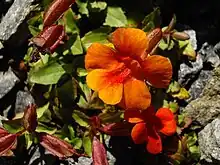| Erythranthe cuprea | |
|---|---|
 | |
| Scientific classification | |
| Kingdom: | Plantae |
| Clade: | Tracheophytes |
| Clade: | Angiosperms |
| Clade: | Eudicots |
| Clade: | Asterids |
| Order: | Lamiales |
| Family: | Phrymaceae |
| Genus: | Erythranthe |
| Species: | E. cuprea |
| Binomial name | |
| Erythranthe cuprea | |
| Synonyms[1] | |
| |
Erythranthe cuprea is a species of monkeyflower also known by the common name flor de cobre (Eng: copper flower). It was formerly known as Mimulus cupreus.[1][2][3][4] Its characteristics in nectar and petal shape are markedly different from other species in this genus found in Chile.[5]
Distribution
Erythranthe cuprea is endemic to central and southern Chile with wet locales such as riverbanks.[6] Several commercial cultivars are available: 'Fire Dragon', 'Fire King', 'Highland Red', 'Inshriach Crimson', 'Plymtree', 'Red Emperor', 'Scarlet Bay', 'Scarlet Bee', 'Whitecroft Scarlet' and 'Wisley Red'. Many of these cultivars are hybrids with Erythranthe lutea or Erythranthe guttata.[7][8]
Description
Similar to E. lutea but of a short life span, Erythranthe cuprea has atypical flower coloring, being coppery-orange to coppery-red, whereas most monkey-flowers are yellow or red, though occasional yellow morphs are found.[6] This does not affect pollination by bees and E. cuprea possesses a high degree of self-pollination.[7] Leaves have teeth and are oval. The plant grows to about 20–30 centimeters (7.9–11.8 in) in height and flowers are 4 centimeters (1.6 in) in length. Flowering occurs in the summer.[9]
Phytochemistry
Petal-color polymorphism is controlled by a single locus; petal and dorsal coloring is co-inherited, indicating single or linked control.[6] The red-copper color of the flowers is caused by a water-soluble pigment, cyanidin, which is an anthocyanin,[10][11][12] acquired through a gain-of-function mutation. An unusual feature is that a similar mutation in a different gene has occurred in E. lutea, but "the loci are related through duplication."[13]
Cultivation
This short-lived perennial is cultivated as an ornamental, and is often treated as an annual. In the horticultural literature it is still referred to as Mimulus cupreus. The cultivar 'Whitecroft Scarlet' has gained the Royal Horticultural Society's Award of Garden Merit.[14] It requires a sheltered spot in reliably moist soil, preferring partial shade.
References
- 1 2 Barker, W.R.; Nesom, G.L.; Beardsley, P.M.; Fraga, N.S. (2012), "A taxonomic conspectus of Phrymaceae: A narrowed circumscriptions for Mimulus, new and resurrected genera, and new names and combinations" (PDF), Phytoneuron, 2012–39: 1–60
- ↑ Beardsley, P. M.; Yen, Alan; Olmstead, R. G. (2003). "AFLP Phylogeny of Mimulus Section Erythranthe and the Evolution of Hummingbird Pollination". Evolution. 57 (6): 1397–1410. doi:10.1111/j.0014-3820.2003.tb00347.x. JSTOR 3448862. PMID 12894947.
- ↑ Beardsley, P. M.; Olmstead, R. G. (2002). "Redefining Phrymaceae: the placement of Mimulus, tribe Mimuleae, and Phryma". American Journal of Botany. 89 (7): 1093–1102. doi:10.3732/ajb.89.7.1093. JSTOR 4122195. PMID 21665709.
- ↑ Beardsley, P. M.; Schoenig, Steve E.; Whittall, Justen B.; Olmstead, Richard G. (2004). "Patterns of Evolution in Western North American Mimulus (Phrymaceae)". American Journal of Botany. 91 (3): 474–4890. doi:10.3732/ajb.91.3.474. JSTOR 4123743. PMID 21653403.
- ↑ Cooley, Arielle M.; Carvallo, G.; Willis, John H. (February 2008). "Is Floral Diversification Associated with Pollinator Divergence? Flower Shape, Flower Colour and Pollinator Preference in Chilean Mimulus". Annals of Botany. 101 (5): 641–650. doi:10.1093/aob/mcn014. PMC 2710177. PMID 18272528.
- 1 2 3 Cooley, Arielle M.; Willis, John H. (2009). "Genetic divergence causes parallel evolution of flower color in Chilean Mimulus". New Phytologist. 183 (3): 729–739. doi:10.1111/j.1469-8137.2009.02858.x. PMID 19453433.
- 1 2 Bryant, T. A. (April 2008). "ContentSelect- Monkeyflowers, bees – but no birds". Annals of Botany. 101 (5): v–vi. doi:10.1093/aob/mcn037. JSTOR 43575860. PMC 2710183.
- ↑ "Mimulus cupreus". Alpine Garden Society. Retrieved 12 February 2017.
- ↑ "Mimulus cupreus 'Whitecroft Scarlet'". Royal Horticultural Society. Retrieved 12 February 2017.
- ↑ Goodwin, T. W.; Thomas, D. M. (January 1964). "The carotenoid pigments in the petals of Mimulus cupreus and Mimulus tigrinus". Phytochemistry. 3 (1): 47–50. Bibcode:1964PChem...3...47G. doi:10.1016/S0031-9422(00)83993-X.
- ↑ Cooley, Arielle Marie (2008). Evolution of Floral Color Patterning in Chilean Mimulus. Durham. NC: Duke University. pp. 9–15, 58. ISBN 978-0549898689.
- ↑ Streisfeld, Matthew A.; Rausher, Mark D. (March 2011). "Population Genetics, Pleiotropy, and the Preferential Fixation of Mutations During Adaptive Evolution". Evolution. 65 (3): 629–642. doi:10.1111/j.1558-5646.2010.01165.x. JSTOR 29782952. PMID 21054357. S2CID 33188741.
- ↑ Cooley, Arielle M.; Modliszewski, Jennifer L.; Rommel, Megan L.; Willis, John H. (April 2011). "Gene Duplication in Mimulus Underlies Parallel Floral Evolution via Independent trans-Regulatory Changes". Current Biology. 21 (8): 700–704. doi:10.1016/j.cub.2011.03.028. PMID 21474312.
- ↑ "Mimulus cupreus 'Whitecroft Scarlet'". RHS. Retrieved 6 January 2021.